Anyone receiving messages send from Japanese cell phones to their Gmail or Yahoo mail (or Hotmail?) account may have noticed that Emoji can be displayed in your web mail inbox. The newest update to Google Labs, the optional experimental features that can be enabled in the settings screen, now has a feature called “Extra Emoji”, which when enabled allows for the insertion of emoji into ordinary email messages. When I realized that emoji support was included in all iPhones, even though it was disabled by default in those sold outside of Japan, I predicted that they would soon be spreading worldwide, and it looks like I was right. As far as I know, this makes Gmail the first non-Japanese service to seamlessly implement emoji input, but expect Apple to enable emoji on non-Japanese iPhones and for more systems to support this gradually spreading standard in the near future.
Author: Roy Berman
Hamaotsu at night [Photo]
That’s how they bill for data use in Japan
Slate’s tech columnist recently suggested that AT&T Wireless (and presumably other wireless network service providers) move from an unlimited data plan to a tiered plan that rewards lower end users and punishes the heaviest users. Although the heavy users would end up paying more, the goal is actually not to extract the most money from customers, but to encourage them to reduce their usage, even at the cost of of lower per-user profit. United States wireless networks, like much of our infrastructure in most of the country, is under-developed and over-utilized, and groaning under the pressure. By providing financial incentives to users to monitor and restrain their use, the idea goes, network utilization would go down in the short term enough to keep the network stable, and there would be time for upgrades.
How would my plan work? I propose charging $10 a month for each 100 MB you upload or download on your phone, with a maximum of $40 per month. In other words, people who use 400 MB or more per month will pay $40 for their plan, or $10 more than they pay now. Everybody else will pay their current rate—or less, as little as $10 a month.
This is of course basically how the Japanese company Softbank bills for Internet utilization on their phones, including the iPhone. (I believe PCS companies like eMobile actually introduced unlimited usage plans first.) While their billing system works at a more granular level, the individual packet, the overall effect is similar. If you barely connect to the network that month, your basic network charges may come to around $10, with metered usage up to a cap of around ¥4000, or around US$40. Of course, since Japan has historically not offered unlimited data plans, the introduction of this billing system was in some ways received in the opposite way that it would be in the US. That is, Japanese wireless companies historically charged purely metered rates, while US providers have mostly offered unlimited plans. While the introduction of a tiered pricing system was considered a customer-friendly innovation in Japan, as it finally made it possible to use your wireless phone as much as you wanted without worrying about the bill, I wonder how Americans, so used to buffet-style pricing, would react.
Halal food in Kyoto University is news?
The Japan Times posted the following small item from Kyodo News:
Kyoto University will start providing food permissible under Islamic law at the school’s cafeteria to meet the needs of the increasing number of Muslim students on campus.
The cafeteria will introduce a halal food corner from Tuesday, avoiding pork and seasonings of pork origin, which Muslims are banned from eating. The new menus include chicken and croquettes made of broad beans, it said.
More than 1,000 Muslims live in the city of Kyoto, and many are Kyoto University students and their families.
The rare introduction is aimed at supporting such Muslim students, whose population is expected to rise under the university’s plans to accept more foreign students.
While the co-op said it had problems in arranging a cooking environment to avoid mixing pork and related seasonings with halal food, it solved the issue by preparing the food at different hours.
The odd thing is that they have actually been serving dishes labeled as Halal in the main cafeteria (中央食堂) since, at the very least, when I arrived in April of last year. I’m rather puzzled at why something that they have been doing for some time would be reported as news.
Cooperative Dragonfly [Photos]
Just to break things up between the two very intense posts on the intricacies of international divorce proceedings and an even more grim post that I’m in the middle of, here are some neat photos of a dragonfly I took the other week when I was in Tokyo. Dragonflies are gorgeous little creatures, and I’d never gotten a very good shot of a living one before, but this one was perched on a wire fence at arm’s length, and just flew back and forth between two nearby spots, instead of escaping completely. Sometimes it’s nice to take a break from street photography and work with a cooperative model.
September 26, 2009. Canon 50D w/ 50mm 1.8F lens.
Tokyo, Japan. (3 photos above.)
By contrast, last month I got the following shot of a deceased dragonfly laid out nicely on the sidewalk in my home town. Definitely a very attractive specimen, but also very much lacking in vitality.
August 31, 2009. Canon 50D w/ 17-85 EF-S lens.
Montclair, New Jersey. USA.
(Click on any image for larger version.)
Open House New York
Next weekend, October 10 and 11, New York City will have its 7th annual Open House weekend, in which hundreds of normally closed-off sites, both public and privately owned, will be open to the masses for tours. I absolutely love this concept, and wish both that it existed in other cities, but even more that I had heard of it while I was home during that weekend in past years!
New York Times has an article on the event.
Official website, with details and schedules, is here.
I hope that every single reader in the NYC area takes advantage of this special opportunity, and if any of you do so, please drop a comment to say what you managed to visit.
Lemons into lemonade? DIY macro lens
Almost as soon as I got back to my house in Kyoto, I slipped down the stairs and bruised the fuck out my left butt-cheek, which currently displays a prominent horizontal black-and-blue line. This was not an auspicious start. The next day, when I stopped by a bicycle shop to get some air in my tires, I accidentally jerked my iPhone out of my pocket via the headphone cable, upon which it plummeted in a dead drop directly into the spikey concrete underfoot, shattering the screen like a cobweb. After a moment of horror, I went directly to the Softbank shop, where they swapped it for a fresh one at a very unpleasant cost of ¥22,800, mollified only very, very marginally by the fact that it only took about ten minutes, and that iTunes does a good job of backing up all of the data on my PC.
Yesterday afternoon, I joined my friend Kate on an expedition to Fushimi Ward, in southern Kyoto City, to recover two bicycles of hers that had been impounded the previous day when she and a friend parked illegally while having dinner downtown. (See Adam’s post on bicycle collection.) I brought my camera along, hoping to take some photos of the lot, but as soon as I arrived I pulled out my camera from my bag and saw that the lens had been broken entirely in half! Luckily I was only using my Canon 50mm 1.8F, the cheapest SLR lens currently (if not ever) made, which retails for under $100, so the loss was relatively minor, and I do have several other lenses I can use, but following on the heals of the iPhone disaster I was still very, very pissed.
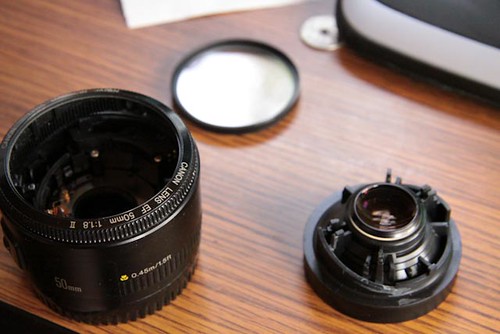
Upon returning home I pondered whether this would be a good chance to upgrade to the 1.4F version, which allows for even more dramatic depth of field, has a superior focusing mechanism, and also a superior level of build quality that does not lend itself to breaking in twain, but decided that at this time I don’t have another $300 to blow on top of the replacement cost, and just ordered a replacement of the broken model from Amazon Japan for ¥8,800. While I had first thought of it as a pure loss, this morning an idea occurred to me.
I had read in the past that in older, fully manual, camera systems it used to be common to mount a second lens backwards onto the front of the lens being mounted in the ordinary fashion, as a makeshift macro lens. A macro lens is a type of lens that is specially built to allow for extremely closeup focusing, enabling the photographer to create dramatic closeup photographs which show extreme detail, almost like a weak but highly portable microscope. You have probably seen many examples in nature photography.
Anyway, I decided to see how it would work with my broken lens, so I mounted the 17-85 EF-S lens on my camera, held the front part of the broken lens (right hand side piece in the above photo) up to the mounted lens, with the previously outer-facing side of the lens facing towards the camera body, and then checked to see what I could do with manual focus. Well, the first shot (of my knee hair) actually looked pretty cool.
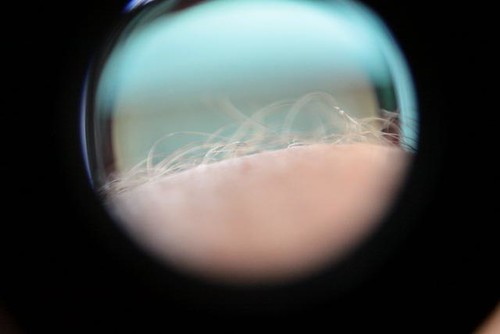
Next I tried the one yen coin and dirty lens cloth sitting on my desk, and then took comparison shots using the 17-85 lens by itself, to contrast the level of magnification provided by the conventional lens and the DIY macro. Note that none of these photos are cropped, magnified, or adjusted in any way.
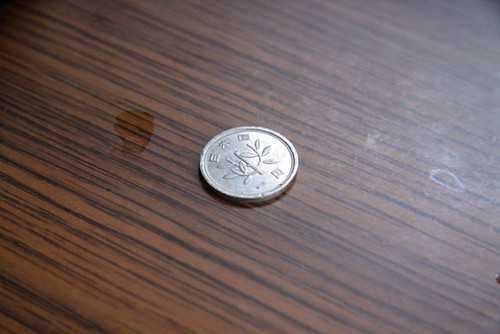
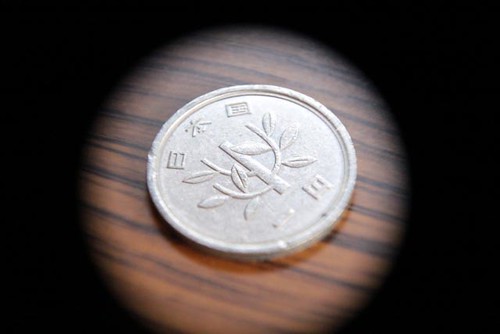
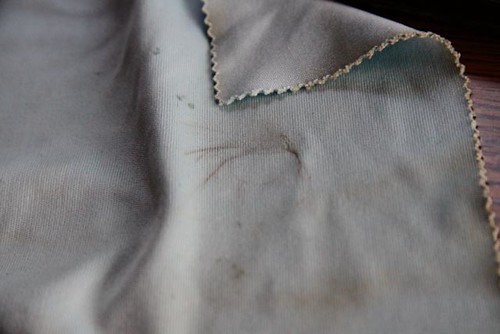

As you can see, the DIY macro provides significant magnification when compared with the standard lens, over 100% larger, as well as a quirky DIY fisheye effect reminiscent of toy cameras like the Holga. While I might not have ever thought to destroy my lens for such a use, it may actually be worth the cost to play around with it in this way. While these photos were taken in a very makeshift way, by holding everything in place using both hands, both knees, and a funny crouch in my chair, the next step will be to purchase a lens cap for the 17-85 lens, cut a hole out in the middle, and construct a DIY mount that allows me to safely walk around with the makeshift macro. I may also experiment with removing the lens from its plastic enclosure and seeing how it performs when held closer to the primary lens. I’ve wanted a macro lens for a long time, and while this is hardly the way I would normally have considered going about acquiring one, it should be a lot of fun to play with.
Hopping back to Japan
I arrived back in Kyoto Wednesday night, after a one month trip to the US. During the three weeks at home in Montclair, New Jersey and the five days in San Francisco on the way back to Japan I kept my Internet usage to a minimum, did virtually no blogging, read a lot of books, ate and drank a lot, and generally had a vacation. Living in the suburbs of New York City, I naturally spend a lot of time there, and I noticed the following changes while I was back.

There are bike lanes all over Manhattan, and people biking all over the place.


The much heralded conversion of Times Square and sections of Broadway into pedestrian only zones actually happened.

Subway cars with modern electronic signage are gradually spreading. Of course, the MTA only introduced them when retiring cars that are too old to remain in service, so it may very well be another decade or two before they are ubiquitous.
I had never been to San Francisco before, and I was very impressed by the food and general atmosphere, and could easily imagine myself living in that climate year-round. The one slice of pizza I had, however, was an unmitigated disaster, not helped by the fact that it was 3am and I was walking the wrong direction. It was also a bit disconcerting, although not unwelcome, after having just been in the New York area, to be in a major American city where residents feel comfortable smoking marijuana in public, at any time of day and in any neighborhood, and even in front of the police.
Upon landing in Kansai International Airport, I noticed two new things.
First, that there is a dedicated line at immigration for reentry permit holders. Before the recent re-introduction of mandatory fingerprinting for entering foreigners, we re-entry permit holders had the unique right of being able to choose EITHER the Japanese citizen lines OR the foreigner lines, whichever was shorter. However, immediately after the institution of the electronic fingerprinting and facial photographing system, we were lumped in with the general foreigner population. But now, and I do not know when it started, we get our very own line. And while both Japanese and visiting foreigners were piled up 3o deep behind green and red ropes, with a solid wait ahead of them, I managed to glide through the yellow-roped corridor with only one person ahead of me and no more than four behind.
Second, that there are drug detection dogs crawling all over the baggage claim/customs area, and the PA system never shuts up reminding you that they don’t bite. While the dogs themselves are not particularly annoying and it is mildly interesting to watch them work as I wait for my luggage to come out, there is still something a bit uncomfortable about having ones person repeatedly inspected, even if only olfactorily. Needless to say, having just come from San Francisco, where-as I mentioned above-marijuana is basically legalized, I found it a particularly unwelcoming welcome back. While the increased dog inspections are obviously a product of Japan’s recent craze of 1950s-esque reefer madness, having such dogs at the border still feels a bit pointless since, as far as I have heard, all of the marijuana consumed in Japan is actually produced domestically up in Hokkaido and Tohoku, and not smuggled into the country.
Regardless, the convenience of the MK Shuttle and almost comical politeness of the engloved driver provided a sharp contrast to the mildly surly and heavily burly Russian or Eastern European immigrant that had driven my corresponding airport pickup shuttle service in San Francisco.
Using a cell phone as visitor to the States
One of the perennial annoyances of world travel in the early 21st century is the difficulty inherent in having the wireless connectivity abroad upon which one has become dependent in one’s country of residence. To say, having operable cell phone service. Yes, the entire world now generally recognizes GSM and unless you are foolish enough to travel abroad with a CDMA only provider like America’s Verizon or Sprint, or Japan’s AU, then your foreign phone shall operate locally, but with the combination of using a foreign phone number and operating said number in a foreign land under a roaming agreement, which produces a particularly usurious fee schedule, wherein a simple text message or phone call of greetings is so expensive as to chill the blood and whiten the face.
The solution to this problem is inherent in the same GSM specification that allows phones and service provider accounts of most nations and varieties to operate worldwide – the SIM card. In most countries, a traveler may simply peruse a local vendor of inexpensive SIM cards offering a reasonably priced prepaid service, whether said vendor be official company store, or marketplace stall, or even automated machine, and after completing the local procedure shall simply replace their existing SIM card, being extremely careful not to lose it, whereupon he or she then has a local phone number.
The difficulty of obtaining such a prepaid SIM card varies greatly by nation. In my experience, the most difficult of all is Japan, where they are simply not sold; the only options for the foreign traveler is to cavort without a cell phone, in the manner of a twentieth century hobo, or to pay a truly outrageous fee for a rental phone or the aforementioned international roaming service. The easiest of all may be The Philippines, where there is a SIM card vending machine located in the lobby of the international airport, allowing one to purchase the chip without providing any personal identifying information, or even to interact with a human being. Someone higher on the scale is Taiwan, where the item may be purchased cheaply and readily at any of the innumerable vendors dotting the market-places, but where the traveler is required by law to show both one’s passport and a supplemental form of identification, quite a burden for a thing so small.
And this brings me to today. Here I am, in my country of citizenship and birth, but only for a short time. Far too short a time to obtain the ongoing contractual wireless service of a resident, and yet far too long, and with far too busy a calendar of engagements to vainly search for working examples of the antiquated coin-phone, or to scurry from doorway to doorway, in search of an unprotected WiFi signal, like a starved and lonely rat trapped out in a storm, trying to sniff its way home before the scent fades.
Here in the US we have two providers of GSM service. AT&T and T-Mobile. Yesterday I was in Manhattan, I believe at 6th Avenue and 17th Street, where stores of these competing firms stared down each other across the Avenue (increasingly full of bicyclists, in these recessionary days). I first inquired at AT&T, the original provider of my retired Samsung Blackjack, now being asked to come out of retirement for one more short campaign. Absurdly, they told me that the fee for a SIM card was $100, with $100 worth of service included. So, there is no base fee but I would be required to spend far more money than I will actually use. And across the way, loquacious Dennis of the T-Mobile store, resident of The Bronx, informs me that their basic fee is a mere $10, with service structure that becomes increasingly favorable (to both parties) the more credit one purchases, in the grand mercantile tradition of the bulk discount.
In fact, it turns out that my old Blackjack was still SIM-card locked to AT&T (meaning that it would not work with any other provider), but either a law of congress or regulation of the FCC now requires that providers of services provide the code needed to unlock said lock, which AT&T (relevant tech support # is 1-800-331-0500 ) did most readily upon request. And now, here I sit, surrounded by phones and computers of divers sizes and capabilities, but amidst them is a single unit, made in Korea, purchased in New Jersey some years ago, containing within itself an accurate and complete record of the telephone numbers of family, friends, associates and acquaintances domiciled in these United States, and once again with the capacity and license to contact them.
loquacious
Off for home
Quick update here, I’m heading off for home (Montclair, New Jersey) in a few hours, by way of San Francisco. I’ll be in the NJ/NYC area until September 10 and then in San Francisco until the 15th, before I head back to Kansai. While at home I’ll probably also make a brief visit to DC for a couple of days. I’m going to try to stay mostly off-line and read more books while I’m at home, but anyone in those areas feel free to drop me a line and I’ll see if I have room in my schedule to meet up.
Just for fun, here’s a (hopefully) complete list of electronics on my person and baggage as I travel.
iPhone (SIM-locked for Softbank, Japan)
External extra battery for iPhone.
Creative Zen Vision:M 60GB (Just in case I run out of iPhone juice entirely.)
Samsung Blackjack (my old phone from last time I lived in US, intend to use with prepaid SIM card while at home.)
Some junky generic Motorola phone (my travel phone when going around Asia. Just in case.)
Asus eeePC 1000
Canon 50D w/ two 8-GB memory cards, 3 batteries and a charger
^ Canon 50mm 1.8F lens
^ Canon 17-85 EF-S lens
^ Tokina 11-16 lens
Sharp electronic dictionary
External USB hard drive (backup of my important files, to leave at home as ultimate emergency off-site backup and swap for a fresh backup drive.)





